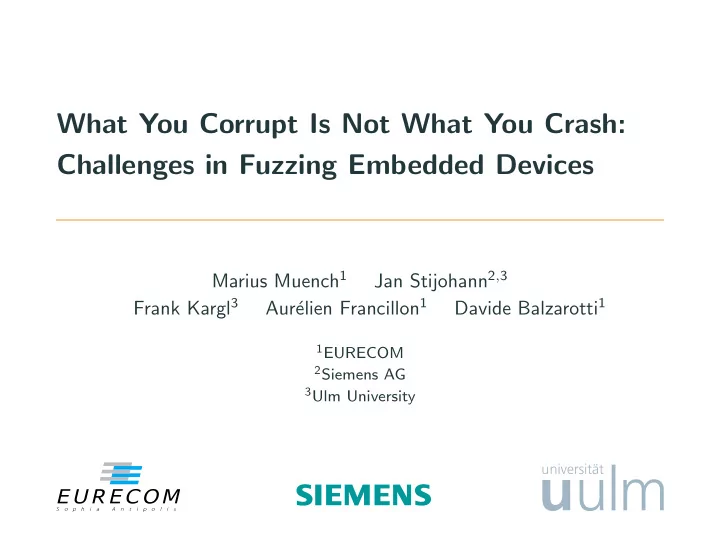

What You Corrupt Is Not What You Crash: Challenges in Fuzzing Embedded Devices Marius Muench 1 Jan Stijohann 2 , 3 Frank Kargl 3 elien Francillon 1 Davide Balzarotti 1 Aur´ 1 EURECOM 2 Siemens AG 3 Ulm University
Introduction • Embedded devices are becoming increasingly more important • Vulnerabilities go beyond misconfigurations, weak authentication, hard-coded keys, etc. • Fuzz testing is a popular and effective method for uncovering programming errors • A variety of work improves input generation and fault detection for fuzzing 1
Problem Statement How efficient are we at fuzzing embedded devices? Can we do it better? 2
Fuzzing, Corruptions & Crashes
Starting Point Corruption � = Crash 3
Embedded Devices: A minimalistic classification Type-I: Type-II: General purpose OS-based Embedded OS-based Type-III: No OS-Abstraction 4
Challenge #1: Fault Detection • Lack of basic features, such as: • Memory Management Unit (MMU) • Heap consistency checks • Canaries • Often only solution: Basic liveness checks 5
Challenge #2: Performance & Scalability • Fuzzing greatly benefits from parallelization • This would mean 1 device per instance • Frequent restarts are required • Fast for software, slow for full systems 6
Challenge #3: Instrumentation • Hard to retrieve coverage information • Tools for turning silent corruptions into observable ones rarely available • Unsupported instruction set architecturess • Operation tied to OS-specific features 7
Measuring the effect of memory corruptions • Five common types of memory corruptions • Insertion of artificial bugs in two popular open source programs • Expat • mbedTLS • Trigger condition inspired by LAVA [1] • Vulnerable programs are compiled for four different devices [1] Dolan-Gavitt, Brendan, et al. ”Lava: Large-scale automated vulnerability addition.” IEEE Symposium on Security and Privacy (SP), 2016. 8
Effects of Corruptions accross different systems Platform Desktop Type-I Type-II Type-III Format String ✓ ✓ ✗ ✗ ! ✓ Stack-based buffer overflow ✓ ✓ (opaque) (hang) ! Heap-based buffer overflow ✓ ✗ ✗ (late crash) ✗ Double Free ✓ ✓ ✗ (malfunc.) ✓ ✗ Null Pointer Dereference ✓ ✓ (reboot) (malfunc.) 9
Possible Directions for Improvement • Static Instrumentation • Binary Rewriting • Pysical Re-Hosting • Full Emulation • Partial Emulation • Hardware-Supported Instrumentation 10
Possible Directions for Improvement • Static Instrumentation • Binary Rewriting • Pysical Re-Hosting • Full Emulation • Partial Emulation • Hardware-Supported Instrumentation 10
Leveraging (partial) emulation to improve fuzz testing
Set-up: Overview Avatar 2 boofuzz PANDA Embedded Device Fuzz Inputs Analysis Emulation MMIO Peripherals Plugis Figure 1: Setup for fuzzing utilizing partial emulation Code will be available at: https://github.com/avatartwo/ndss18_wycinwyc 11
Set-up: Target • The vulnerable expat program, as seen in the last part • Focus on a Type-III device • Fuzzed in four different configurations 12
Set-up: Native Avatar 2 boofuzz PANDA Embedded Device Fuzz Inputs MMIO Peripherals Analysis Emula � on Plugis 1. Native (NAT) 2. Partial Emulation with Memory Forwarding (PE/MF) 3. Partial Emulation with Peripheral Modeling (PE/PM) 4. Full Emulation (FE) 13
Set-up: PE/MF Avatar 2 boofuzz PANDA Embedded Device Fuzz Inputs MMIO Peripherals Analysis Emula � on Plugis 1. Native (NAT) 2. Partial Emulation with Memory Forwarding (PE/MF) 3. Partial Emulation with Peripheral Modeling (PE/PM) 4. Full Emulation (FE) 14
Set-up: PE/PM Avatar 2 boofuzz PANDA Embedded Device Fuzz Inputs MMIO Peripherals Analysis Emula � on Plugis 1. Native (NAT) 2. Partial Emulation with Memory Forwarding (PE/MF) 3. Partial Emulation with Peripheral Modeling (PE/PM) 4. Full Emulation (FE) 15
Set-up: FE Avatar 2 boofuzz PANDA Embedded Device Fuzz Inputs MMIO Peripherals Analysis Emula � on Plugis 1. Native (NAT) 2. Partial Emulation with Memory Forwarding (PE/MF) 3. Partial Emulation with Peripheral Modeling (PE/PM) 4. Full Emulation (FE) 16
Set-up: Fuzzer • boofuzz [2], a python-based fuzzer based on Sulley • Configured to trigger the corruptions with different ratios • Used for 100 fuzzing sessions over one hour each [2] https://github.com/jtpereyda/boofuzz 17
Set-up: Corruption Detection Avatar 2 boofuzz PANDA Embedded Device Fuzz Inputs MMIO Peripherals Analysis Emula � on Plugis 1. Native (NAT) 2. Partial Emulation with Memory Forwarding (PE/MF) 3. Partial Emulation with Peripheral Modeling (PE/PM) 4. Full Emulation (FE) 18
Set-up: Corruption Detection Avatar 2 boofuzz PANDA Embedded Device Fuzz Inputs MMIO Peripherals Analysis Emula � on Plugis 1. Native (NAT) 2. Partial Emulation with Memory Forwarding (PE/MF) 3. Partial Emulation with Peripheral Modeling (PE/PM) 4. Full Emulation (FE) 19
Set-up: Corruption detection • 6 simple heuristics, monitoring the execution: 1. Segment Tracking 2. Format Specifier Tracking 3. Heap Object Tracking 4. Call Stack Tracking 5. Call Frame Tracking 6. Stack Object Tracking 20
Measuring Fuzzing Throughput No Heuristics: Native Partial Emulation/Memory Forwarding Partial Emulation/Peripheral Modeling Full Emulation 10 4 Combined Heuristics: Partial Emulation/Memory Forwarding' Partial Emulation/Peripheral Modeling' #Inputs Full Emulation' 10 3 10 2 0 5 10 Corruption Ratio [%] 21
Discussion, Future Work & Conclusion
Insights from the experiments • Liveness checks only is a poor strategy • Full emulation is good - but rarely possible • Partial emulation can already help • But introduces significant performance overhead 22
Limitations and Future Work • We focused on improving fault detection • Other challenges of fuzzing (e.g., input generation) not addressed in this work • Our experiments focused on artificial vulnerabilities • Good for improving our initial understanding • We investigated solutions based on partial emulation • Other approaches still open for research 23
Conclusion • Fuzzing embedded devices requires a paradigm shift • (Partial) emulation can improve fault detection • We need good emulators • Fuzzing of embedded devices needs more investigation 24
Recommend
More recommend